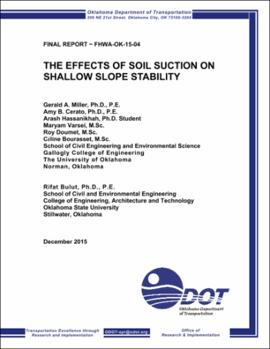| dc.creator | Miller, Gerald A. | |
| dc.creator | Cerato, Amy B. | |
| dc.creator | Hassanikhah, Arash | |
| dc.creator | Varsei, Maryam | |
| dc.creator | Doumet, Roy | |
| dc.creator | Bourasset, Celine | |
| dc.creator | Bulut, Rifat | |
| dc.date.accessioned | 2017-12-20T23:13:19Z | |
| dc.date.available | 2017-12-20T23:13:19Z | |
| dc.date.issued | 2015-12 | |
| dc.identifier.govdoc | FHWA-OK-15-04 | |
| dc.identifier.other | Oklahoma Department of Transportation State Planning and Research item number 2160 | |
| dc.identifier.uri | https://hdl.handle.net/11244/54278 | |
| dc.description.abstract | Research work described in this report was undertaken to improve understanding of desiccation cracking and shallow slope failures in clayey slopes subjected to seasonal variations in weather. Research involved field and laboratory testing and computer modeling. Two test sites where shallow slope failures had occurred were instrumented with weather monitoring equipment and sensors to measure variations in soil moisture. The purpose was to examine the variations in soil moisture, and hence shear strength, as a function of time and depth. A primary goal was to evaluate two commercially available computer programs with respect to their ability to predict soil moisture changes and suction. Results of the study indicated that reasonable predictions of soil moisture changes due to weather are possible with commercial software but considerable effort is needed for parameter determination, model calibration and validation. Unsaturated seepage analyses provided insight into pore water pressure development in the slopes considering the impact of desiccation cracking. The results suggest that desiccation cracks may increase the mass hydraulic conductivity of the near surface soils by one to two orders of magnitude. Further, results of seepage analyses suggest that upper layers of the slope soil profile may become nearly saturated in some areas with positive pore water pressure developing over a significant portion of the failure surface. Unsaturated slope stability analyses were conducted using the predicted pore pressure distributions from unsaturated seepage models and unsaturated strength parameters determined from suction-controlled direct shear tests on compacted soil. In addition, traditional slope stability analyses were conducted using drained shear strength parameters and assumed positive pore pressures. Both methods provided reasonable predictions of the failure conditions (factor of safety of 1) for the two sites; however, both have advantages and disadvantages relative to one another. A simple method of predicting the depth of desiccation cracks in compacted soil was developed based on linear elastic theory and shows promise relative to observations at one of the test sites. Tensile strengths used in crack depth predictions were based on measurements in a new apparatus developed and manufactured at the University of Oklahoma. Theoretical predictions of tensile strength based on a micro-structural effective stress model compared favorably to measured strengths. | |
| dc.format.extent | 192 pages | |
| dc.format.extent | 7,339,733 bytes | |
| dc.format.medium | application.pdf | |
| dc.language | en_US | |
| dc.publisher | Oklahoma City, OK : Oklahoma Department of Transportation, 2015. | |
| dc.relation.ispartofseries | No | |
| dc.relation.requires | Adobe Acrobat Reader | |
| dc.relation.uri | http://www.okladot.state.ok.us/Research/ | |
| dc.title | The Effects of Soil Suction on Shallow Slope Stability / Gerald A. Miller, Amy B. Cerato, Arash Hassanikhah, Maryam Varsei, Roy Doumet, Celine Bourasset, Rifat Bulut | |
| dc.type | Technical Report | |
| dc.description.version | Final report, Oct. 2011-Dec. 2015 | |
| dc.description.peerreview | No | |
| dc.type.material | text | |
| dc.subject.keywords | Climate | |
| dc.subject.keywords | Desiccation cracks | |
| dc.subject.keywords | Slope stability | |
| dc.subject.keywords | Suction | |
| dc.subject.keywords | Tensile strength | |
| dc.subject.keywords | Unsaturated seepage | |
| dc.subject.keywords | Weather | |
| dc.contributor.sponsor | Oklahoma Department of Transportation. Materials and Research Division. Office of Research & Implementation | |
